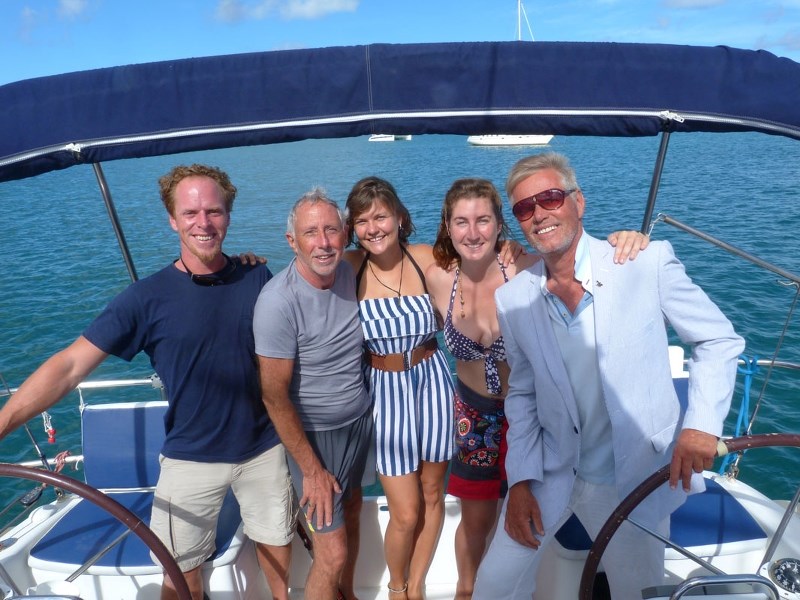You might think that one should have a lot of experience when one decides to sail across Atlantic Ocean. Ulrich Simonsmeier begs to differ.
“Not really that much,” he said, only a few weeks after his return to this city, following his jaunt across the pond. His own rĂ©sumĂ© is perhaps a bit short.
“A lot of it is relative.”
The Atlantic Rally for Cruisers is an annual event put on by the World Cruising Club, an organization that tries to even the playing field for novices to gain the same experiences as the experts. It’s very well organized, he continued, indicating that the WCC makes sure that you’re qualified, conducting safety inspections to ensure that your vessel is up to snuff.
The rally itself consists of a launching point and a destination nearly 3,000 nautical miles away, from Gran Canaria in the Canary Islands near Morocco to Saint Lucia in the Caribbean, a distance that works out to approximately 5,000 km. It was considered a race for more than 20 different crews but Simonsmeier and several other boats preferred to have a leisurely cruise, mostly between eight to 10 knots, taking their sweet time in the sea breeze.
Just because he doesn’t call himself a pro doesn’t mean that he’s a pure novice.
“I’ve been sailing for a long time but I have not put on many sea miles before then. I’ve only done two or three overnight crossings before.”
This time he had 19 overnight crossings and not all of them were smooth sailing. His boat, Blue Swing, is barely 40 feet long, meaning that there’s no room to walk. Everything is “step here, step there … all of the movements are with your hands and feet. You grab something, take a step and make sure you don’t get tossed around by the rocking boat.”
“The sailing part isn’t that difficult, really. Staying on course is no problem: there’s an autopilot,” he said. “The difficult part is coping with changing weather conditions quickly enough.”
Sometimes those changes come in the form of short, intense storms called squalls that last anywhere between 30 minutes to two hours. Some of the sails received some damage because of squalls. One crew member had to dive overboard during a squall because a line went into the drink, getting caught in the propeller.
Other times sailors’ troubles involve social turbulence.
A good amount of successful sailing is done with proper planning like making sure you have enough food and potable water. There was a container of 300 L for each person to have three litres per day. He had a crew of five, including one acquaintance and three that he acquired through a web service.
That might not be the best way to go, as it turns out. Some of the others were perhaps too inexperienced because they used up all of the water after the first week. Simonsmeier speculated that one person in particular had either a language barrier or a personality conflict – “an insensitivity problem,” he said – or both.
“She didn’t understand or didn’t want to comply with the rules. She just showered and washed her hair until the water was gone.”
With no means for making more fresh water, they were left to drink only bottled water and do all of the washing and bathing with salt water.
And then they ran out of cooking gas but that was just because of poor estimating, he admitted. They tried using an oil lamp and tea lights to heat up their food but in the end, most of the meals were straight out of the can. Somebody brought along a huge leg of cured pork from Gran Canaria so at least they all had protein.
“Most people when they think of Atlantic crossing, they think of hardship. I felt, ‘who knows what we’re going to encounter. It might be pretty tough.’ It really was not tough. It was pretty relaxing,” said Simonsmeier.
Sailing, he added, is long periods of relaxation punctuated with brief periods of hectic. You have to be OK with being alone on the open sea. Simonsmeier said that they didn’t see any other boats after day two. He figured that the trip would take 22 days but it only took 19.
While the experience can be chalked up as a personal milestone for many, he said it has added significance to him. It adds further proof that having a kidney transplant doesn’t mean that you have to live landlocked and sheltered from all of the wonders of the world.
“A lot of people would consider that to be rather debilitating, but it is not,” he commended. “People with (kidney transplants) can actually take part in any kind of activity whether it be survival out in the forest or a 19-day trip without water across the ocean.”




